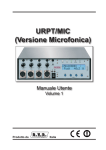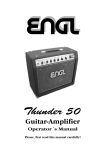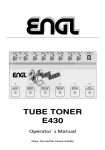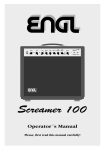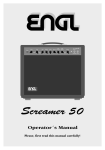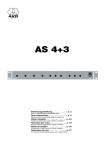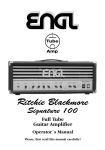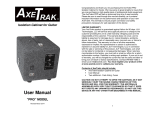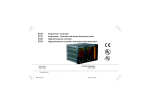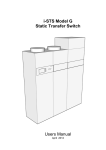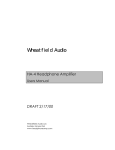Download ENGL Screamer 50 E330
Transcript
Tube Amp Screamer 50 Guitar-Amplifier Operator´s Manual Please, first read this manual carefully! Screamer 50 - delivers the sonic goods—tons of tone and palette of hip sounds from squeaky clean to hi-gain shred and everything in between. This all-tube beast is your first choice for many different sound styles! With a host of practical features and a clearly-arranged control panel, handling this amp is a piece of cake. The Screamer's opulent visuals are certainly arresting, but its unique, creamy tube tone and silky spring reverb truly set this amplifier apart. The Screamer comes complete with a bit of technical wizardry which you'll find useful where it counts most—out there in the real world of rehearsing and gigging. Among these features are a Lo/Hi Gain switch, which in effect doubles your choice of channels from two—Clean and Lead—to four—the afore-mentioned, plus Crunch and Heavy Lead. You also get two different connection systems for different footswitches-conventional ¼" jacks as well as a port for the ENGL compact footswitch Z-5 (optional). And then there's the ingenious feature "V.L.S.", an adapted version of the extremely popular and highly practical Master A/B switching circuit found on high-end ENGL heads. Quality components, excellent workmanship and strict quality control ensure this amp retains its value. You'll find guidelines on care and maintenance of tube amps on the last page of the manual. Please read and heed these before operating your amp. You'll also come across boxes shaded grey throughout the manual. These are located between the descriptions of the amp's functions and contain handy tips on the preceding function. All critical information pertaining to the operation of this amp is preceded by "NOTE" or "CAUTION." Please pay particular attention to these safety tips. The ENGL team wishes you all the best—may you and your amp enjoy a "harmonically rich" future together! Frontpanel Input Clean Lead Bass Middle Treble Lead Presence Reverb Lead Volume Gain Clean Lo/Hi Lead Screamer 50 Master Bright Tube Amp 1 2 3 4 5 6 7 8 9 10 11 12 13 Stand By Power 14 15 1 Input: Input¼" unbalanced input. Plug your guitar cord in here. 2 Clean: Input sensitivity control (Gain) for the Clean and the Crunch channels. 3 4 5 6 7 8 9 (Clean: set the Gain-button 11 to the Lo position, Crunch: set the Gain-button 11 to the Hi position). A TIP from the Designer: Gain settings depend on what type of pickups are installed in your guitar. The recommended setting for humbuckers or active pickups lies between the 10 and 1 o’clock positions and 12 to 3 o’clock for single coils for a pure clean response; the Gain button must be in the OFF-position. Bright: Alters the EQ by boosting the upper treble range; effectiveness decreases at higher Gain (2,4) settings; the Bright feature affects all channels. A TIP from the Designer: For a crisp glassy tone, set the Bright switch to the On position. This setting boosts the treble response of muddy pickups. Lead: Gain control pot for the Soft Lead channel and the Heavy Lead channel. It controls the amount of preamp overdrive in the Lead mode. (Soft Lead: set the Gain-button 11 to the Lo position, Heavy Lead: set the Gain-button to the Hi position). CAUTION: Extremely high gain and volume levels in the Lead mode can produce strong feedback. Avoid feedback squeals, they lead to hearing loss and damaged speakers! A TIP from the Designer: To get Crunch-sounds and Rhythm-sounds set this control between the 9 and 12 o´clock´s position (depending on the type of pick-up) and leave the Gain 11 pusbutton in the Off-position. Bass: Bottom end voicing control of the preamps´s passive EQ. Middle: Mid-range voicing control of the preamp´s passive EQ. Treble: Upper range voicing control of the preamp´s passive EQ. A TIP from the Designer: To get an idea of this amp's capabilities, I suggest you set the tone control pots Bass (5), Middle (6), Treble (7) and Lead Presence (8) to the 12 o'clock position. For extremely soft lead, blues or jazz sounds, try setting the Treble knob to somewhere in the 8-to-11 o'clock range. For aggressive metal riffs or spanky funk sounds, go for something in the range of 11 to 3 o'clock. Lead Presence: This control defines the Treble response in the poweramp stage for the Lead channel. A TIP from the Designer: When you've adjusted the amp to relatively loud levels and high Gain settings reduce the amount of Lead Presence (8) and Treble (7) to prevent annoying feedback that is generated when your guitar's pickups and the speaker interact—something in the 8-to-12 o'clock range should do just fine. Reverb: Reverb control, adjusts the portion of the reverb signal and increases reverb intensity if you rotate it clockwise; the reverb can be switched on/off via the respective footswitch connected to jack 19 or 21. 10 Lead Volume: Volume control for the Lead channel (pre-FX loop, influences the Send level). Use this knob to dial in the desired balance of levels between the Lead and Clean channels. 11 Gain Lo/Hi: When you press this button, the input sensitivity of both channels is increased. 12 13 14 15 The Hi-Gain function actually turns Clean into a "Crunch" channel, and Lead into a "Heavy Lead" channel. It can also be activated via a suitable footswitch connected to Jack 19 or 20; the Gain Lo/Hi button is automatically disabled when you connect a footswitch. The yellow LED illuminates to indicate "Hi-Gain" mode is active. Clean/Lead: Channel selector pushbutton for Clean and Lead modes, red LED indicate Lead mode; This function can also be activated via the respective footswitch connected to jack 19 or 20. Once a footpedal is connected, the channel selector pushbutton is deactivated. Master: Master volume control for power amp output. The feature to switch between two Master volume levels (V.L.S. - Lo or Hi) can be accessed by means of the respective footswitch connected to jack 19 or 20. Adjust the ratio between the two volume levels with the "V.L.S. Ratio" pot (see chapter 18). Stand By: Power amp standby switch: Use this switch to silence (0 position) the amp when you take a lengthier break. The amp's tubes stay warm, which means that it is ready to roll immediately when you switch it back to full power. The standby switch is also well-suited for muting the amp for brief breaks, for instance when you're switching guitars. Power: AC power on/off. Rear Panel CUSTOM FOOTSWITCH PORT CAUTION ! FOOTSWITCH ! BALANCED LINE OUTPUT DO NOT OPEN ! RISK OF ELECTRIC SHOCK ! DO NOT EXPOSE THIS EQUIPMENT TO RAIN OR MOISTURE ! F.X. LOOP Screamer 50 CAUTION ! V.L.S. RATIO Connect To Custom Footswitch Only ! 18 19 20 21 GROUND TO PIN 1 OVERLOAD GROUND LIFTED COMBO: TYPE E330 HEAD: TYPE E335 CLEAN / LEAD V.L.S. GAIN LO/HI REVERB REPLACE FUSE ONLY WITH SAME TYPE AND RATING ! 16 17 POWERAMP OUTPUT R All-tube Guitar Amplifier Amp-Design by Horst Langer SEND RETURN BALANCE DRY EFFECT 22 23 24 MADE IN GERMANY 8 OR 16 AND 16 OR-> 8 OHMS PARALLEL 1 x 8 OHMS 2 x 16 OHMS COMBO: INTERNAL SPEAKER 16 OR 8 AND 8 16 OHMS SERIAL 1 x 16 OHMS (USE LEFT JACK!) 2 x 8 OHMS LINE OUT GROUND 25 26 27 28 29 LEVEL 30 LINE OUT FREQUENCY COMPENSATED 31 32 16 AC Socket: Connect an AC cord here. CAUTION: Ensure you use an intact AC cord with an insulated plug only! Before you power the amp up, ensure the voltage value printed beside the AC socket corresponds to the available current. 17 AC Fuse Box: Contains mains fuse (rear chamber) and spare fuse (front chamber). NOTE: Ensure replacement fuses bear identical ratings (refer to the table)! 18 V.L.S. Ratio: Use this potentiometer to determine the balance between the two master volume levels. We deliberately left the knob off this pot, but you can rotate the shaft to dial in the desired preset. If you're operating the amp without a footswitch, "Master Hi" (high-volume mode) is active and this pot is disabled. You can switch between the Lo and Hi Master volume levels via a standard dual footswitch connected to Jack 21 (or via the MIDI Switcher) or the Custom Footswitch connected to Jack 19. Turn the pot's shaft clockwise to turn up the "Master Lo" level. 19 Custom Footswitch Port: Connect the ENGL Custom Footswitch Z-5 (optional) to this port (Sub-D, 9-pin). This special footswitch lets you activate the four channels directly via dedicated buttons. V.L.S. (Volume Level Switching) and reverb are activated via two additional buttons.When the Z-5 footswitch is connected, the Clean/Lead and Gain Lo/Hi buttons on the front panel as well as footswitch Jacks 20 and 21 are disabled. 20 Footswitch Clean/Lead, Gain Lo/Hi: 1/4" stereo jack for a dual footswitch, executes the following functions: 1. Channel switching between Clean and Lead (mono terminal). 2. Gain Lo - Hi: switches from Clean to Crunch during Clean mode and from Soft Lead to Heavy Lead during Lead mode (stereo terminal). 21 Footswitch V.L.S., Reverb: 1/4" stereo jack for a dual footswitch, executes the following functions: 1. Switching between the two Master volume levels Hi and Lo (mono terminal). 2. Reverb on/off (stereo terminal). Impotant Note: You can use standard dual footswitches that connect the mono or stereo contact of the ¼" jack and its ground. An LED that serves as a status indicator can also be connected in series (power requirements approx. 10 - 20 milliamperes, depending on function). In practice though we've found that not every footswitch by every manufacturer under the sun is compatible. If you choose to use the ENGL Z-3 (basic plastic version without LED display) or ENGL Z-4 (rugged metal version with LED display) footswitches, you won't encounter any compatibility problems. A TIP from the Designer: If you want to control the amplifier via a MIDI system, use jacks 20 and 21 and a Looper or MIDI Switcher (e.g. ENGL Z-11). Use two stereo ¼" cords to connect the ENGL MIDI Switcher Z-11 (optional). You can then preset the four switching functions Clean/Lead, Gain Lo/Hi, V.L.S. and Reverb via the Switcher, store your custom switching setups as different MIDI programs and activate the presets via a MIDI board (e.g. ENGL Z-12). 22 F.X. Loop Send: Signal output for the Effects loop. Connect this output to a signal processor’s input/return jack via a shielded cable with 1/4" plugs. 23 F.X. Loop Return: Signal input for the Effects loop. Connect this input to a signal processor’s output/send jack via a shielded cable with 1/4" plugs. 24 Balance: FX mix control for the Effects loop: Rotate the knob to the "DRY" position for the pure amp signal, i.e. no effect on the signal. Turn clockwise to blend in an effect connected to the loop to the dry signal (parallel/passive). At the "EFFECT" position, only the wet signal, i.e. the signal sent from the FX device is fed to the power amp (serial/passive). NOTE: If no effects processor is connected to this loop, leave this control in the "DRY" position! 25, 26 Poweramp Output 8 ohms parallel: Parallel 8-ohm speaker outs, connected internally in parallel. Connect an 8-ohm cabinet or, in the case of the Combo E330, its internal speaker here. Alternatively, two 16-ohm cabinets can also be connected to these two outputs. 27 Poweramp Output 16 ohms serial: 16-ohm speaker out, connected internally in series with Jack 28. Connect a 16-ohm cabinet here. Two 8-ohm speakers are connected to Jacks 27 and 28, for example a combination of the internal 8-ohm speaker of the Combo E330 and an external 8-ohm cabinet, e.g. the ENGL models E112 or E412. CAUTION: If you intend to use a 16-ohm cabinet only, make absolutely certain you connect it to Jack 27. Jack 28 is only enabled when a speaker is connected to jack 27. 28 Poweramp Output 16 ohms serial: 16 ohms serial. This is an auxiliary output connected in series with Jack 27. This jack is designed for one application for only—when you are driving a combination of two 8-ohm cabinets/speakers. This output may only be used when an 8-ohm speaker is connected to Jack 27. (See the example for Item 27) NOTE: Never operate the amplifier without a sufficient load, otherwise you may damage or destroy the power amp! Ensure your cabinet’s specifications match the respective output’s specs. Possible speaker combinations: 1 x 8 ohms or 2 x 16 ohms (Jacks 25 and 26) or 1 x 16 ohms (Jack 27!) or 2 x 8 ohms (Jacks 27 and 28). 29 Line Out Ground: This switch assigns Pin 1 of the XLR socket to ground (position "Ground to Pin 1"). You'll find this option is handy when you want to shield the circuit you have routed to a mixing console or recording device. In order to come up with an unbalanced signal (e.g. for feeding the signal to a computer for HD recording purposes), you'll need a cord equipped with an XLR connector on one end and an RCA connector or ¼" plug on the other. Pin 2 is used to carry the signal and Pin 1 as the ground (set the switch to the position "Ground to Pin 1"). With this application—an unbalanced circuit—you may encounter a ground loop caused by the respective grounds of the two devices, which will generate audible hum. NOTE: Pin 1 of the balanced line may only be connected to ground on one end (either at the amp or mixer / recording device), otherwise it may cause a ground loop, which in turn generates undesirable hum! 30 Level: Signal level control for the frequency-corrected line output; it is used to match the amp’s signal level at the Line output to the mixing console or recorder’s input. 31 Overload: This LED denotes the Line output is overloading; in this case, reduce the signal’s level via the Level control. 32 Line Out Frequency Compensated The frequency-corrected, balanced Line output jack (XLR; Pin 2 and 3 signal, Pin 1 = Ground or not connected, depending on the setting of switch 29). This signal can be routed directly to a mixing console or a recording unit. The line out is located post poweramp in the signal chain, so ensure the poweramp is activated and a load is connected to one of the output jacks.A A TIP from the Designer: The Line Out’s output level is influenced by the following factors: By the input level (Gain), the Volume control settings for the various channels, to some degree by voicing control settings, and by the Master volume level. First dial in the desired sound combination at the front panel. Then adjust levels at FX devices or signal processors (if connected). Now use the Level control to adjust the Line level. The Line output is not overloaded until the Overload LED illuminates brightly and continuously. You can push the level up to this point to match a mixing console or recorder’s input level requirement. Use the respective device’s input sensitivity or gain control to fine-tune level adjustments. The different options for controlling the Screamer 50 amp remotely: CUSTOM FOOTSWITCH PORT CAUTION ! FOOTSWITCH ! BALANCED LINE OUTPUT DO NOT OPEN ! RISK OF ELECTRIC SHOCK ! DO NOT EXPOSE THIS EQUIPMENT TO RAIN OR MOISTURE ! F.X. LOOP Connect To Custom Footswitch Only ! Amp-Design by Horst Langer SEND 1. RETURN BALANCE DRY EFFECT Crunch Hi Gain Connect To 8 MADE IN GERMANY OR 16 AND 16 OR-> 16 8 OHMS PARALLEL 1 x 8 OHMS 2 x 16 OHMS COMBO: INTERNAL SPEAKER 2. or Custom Footswitch Port Caution ! Custom Footswitch or Lead Hi Gain OR 8 AND 8 16 OHMS SERIAL 1 x 16 OHMS (USE LEFT JACK!) 2 x 8 OHMS LINE OUT GROUND LEVEL LINE OUT FREQUENCY COMPENSATED 3. Serial Number Amplifier Only ! Custom Footswitch Type Z-5 Made in Germany Lead Lo Gain OVERLOAD GROUND LIFTED COMBO: TYPE E330 HEAD: TYPE E335 CLEAN / LEAD V.L.S. GAIN LO/HI REVERB REPLACE FUSE ONLY WITH SAME TYPE AND RATING ! Clean Lo Gain GROUND TO PIN 1 Screamer 50 CAUTION ! V.L.S. RATIO POWERAMP OUTPUT R All-tube Guitar Amplifier Contour Reverb MIDI SWITCHER Master A/B Lo/Hi lifier ON/OFF WRITE lifier Tube Amp Tube Amp ON/OFF ON/OFF MIDI CHANNEL SWITCH LOOP 1 SWITCH LOOP 2 SWITCH LOOP 3 SWITCH LOOP 4 SWITCH LOOP 5 SWITCH LOOP 6 ON/OFF 1. ENGL Custom Footswitch Z-5: Connect it to the "Custom Footswitch Port" (19) port via a 9-pin computer cable. Functions: Direct access to Clean (Clean & Lo Gain), Crunch (Clean & Hi Gain), Soft Lead (Lead & Lo Gain), Heavy Lead (Lead & Hi Gain) as well as V.L.S. and Reverb. This is a very convenient yet compact solution. 2. Dual footswitch (e.g. ENGL Z-4): Connect it to the amp via a stereo ¼" cord. You will need one dual footswitch for switching channels via Jack 20 and another footswitch for switching V.L.S. and Reverb via Jack 21. Functions: Clean/Lead, Gain Lo/Hi, V.L.S., Reverb. With this solution, you can't activate the channels Crunch and Heavy Lead directly, i.e. this requires an intermediate switching operation. 3. MIDI-Switcher (e.g. ENGL Z-11): Connect the board to the amp via two stereo ¼" cords. The buttons on the Switcher control Clean/Lead, Gain Lo/Hi, V.L.S. and Reverb. If you program the diverse switching configurations to different MIDI program locations (e.g. Gain Hi & Lead & Master Lo & Reverb), you can activate the desired configuration directly via a MIDI board (e.g. ENGL Z-12). This type of control option is extremely versatile, we recommend it highly if you intend to use the amp in conjunction with a MIDI system (e.g. MIDI effects devices). Technical Data: Rated power: Tubes: approx. 50 watts at 8 or 16 ohms; V1(input-tube): ECC 83 / 12AX7, FQ Grade; V2, V3: ECC 83 / 12AX7 selected; V4: ECC 83 / 12AX7, standard; V5, V6: 5881 (6L6GC) matched set. Fuses: external: 1 AT (slow) at 230 Volts; 2 AT (slow) in the 100 and 120 Volts models. internal: 1,25 AT (slow) at 230 Volts; 2,5AT (slow) in the 100 and 120 Volts models. Important: Replace fuses only against same type and rating! Power consumption: 155 watts max. Dimensions: Combo E330 approx. 57,5 x 48 x 27 cm, (22,6 W x 18,9 H x 10,6 T) Head E335 approx. 57,5 x 27 x 27 cm, (22,6 W x 10,6 H x 10,6 T) Weight: Combo: approx. 22 kg (48,4 lbs); Head: approx. 18 kg (39,6 lbs); Tube array: Output Transformer V5 V6 V4 Power Transformer V3 V2 Reverb-Connector V1 Handling and Care Protect the amp from mechanical knocks (tubes!). Let the amp cool down before you transport it (approx. 10 minutes). Tubes need about 20 seconds to warm up after you switch the power on, and furtheron a few minutes before they reach their full power capability. Avoid storing the amp in damp or dusty rooms, they are hard on jacks, switches and potentiometers. Make sure air can circulate at the rear and top of the amp to allow for adequate cooling (increases component life). Never operate the amp without an adequate load. Replace tubes with select replacement tubes (special selection criteria) to avoid microfonic properties, undesireable noise and unbalanced performance. Attention! Please read the following! This guitar amplifier can produce high volume levels. Exposure to high volume levels may cause hearing damage! Leave tube replacement and power amp biasing to qualified professionals. Be sure the unit is switched off and unplugged! Caution! Tubes can get very hot and burn skin when touched. Always use high quality cables. Never plug the amp into an ungrounded outlet! Never bridge a defective fuse and be sure replacement fuses feature identical ratings! Pull the AC mains plug before replacing fuses! Never open the chassis or attempt repairs on your own. Consult qualified service personnel! Never expose the amplifier to extreme humidity or dampness! Please read the instructions carefully before operating the unit! Be sure to operate and handle this amp as it was designed for. To this end, please heed the instructions in the operator's manual. You'll find an additional pamphlet accompanying this owner's manual entitled "Instruction for the prevention of fire, electric shock or injury of persons". Be sure to read it before you plug the preamp in and switch it on! ENGL Gerätebau GmbH Internet: www.engl-amps.com Text, design, grafics, photographies and layout by Horst Langer We reserve the right to make unannounced technical upgrades!






